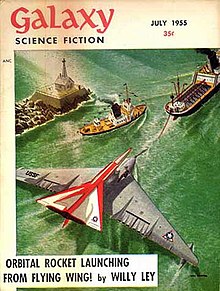Willy Ley
Willy Otto Oskar Ley (October 2, 1906 – June 24, 1969) was a German and American science writer and proponent of cryptozoology.
"[5] He then became interested in spaceflight after reading Hermann Oberth's book Die Rakete zu den Planetenräumen (The Rocket into Interplanetary Space).
Although it was a difficult technical book, Ley worked through the calculations and concluded that outer space would soon become the next great frontier of human exploration.
Due to the influence of Ley and other popular science writers, such as Max Valier, Germans witnessed a short-lived "rocketry fad" in Berlin.
Yet for the most part, Ley turned back to his original scientific interests, while writing a biography of Conrad Gessner (the "father" of modern zoology).
His perception of political events can be inferred from a short science fiction story "Fog", which Ley wrote in 1940 under the pen name of Robert Wiley.
In fact, John Campbell, the editor of Astounding, requested that Ley center the narrative on his personal experience.
[10] To make matters worse, Ley had an established reputation as an international scientist, who openly shared and popularized technical information about rocketry, while his articles continued to be republished by foreign newspapers throughout 1934.
[18] Fellow Galaxy columnist Floyd C. Gale wrote that Ley "has become as familiar to TV audiences as Howdy Doody".
Likewise and long after his death, Larry Niven and Steven Barnes named a future Space Shuttle the “Willy Ley” in their 1982 novel The Descent of Anansi.
These included accurate predictions of the Channel Tunnel between Britain and France and commercial wind, solar and geothermal power.
Other schemes were less practical: damming the River Jordan to provide power and irrigation to Israel/Palestine and the plans of fellow German Herman Sörgel to drain the Mediterranean to link Europe with Africa and create the new continent of Atlantropa.
He was a member of the all-male literary banqueting club the Trap Door Spiders, which served as the basis of Isaac Asimov's fictional group of mystery solvers the Black Widowers.
Science historian Brian Regal has noted that Ley "copied entire chapters of Heuvelmans's On the Track of Unknown Animals for his own reference.




